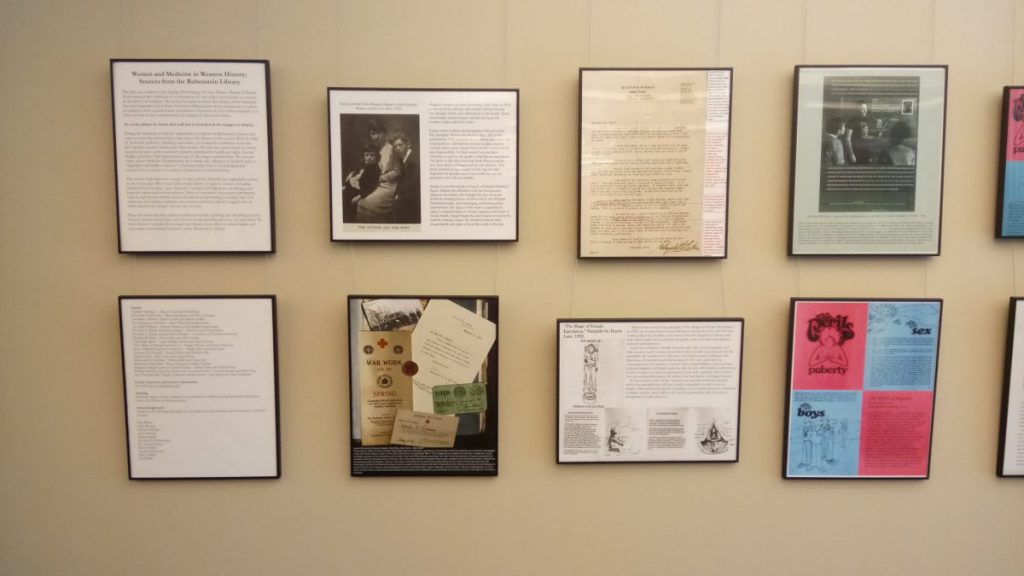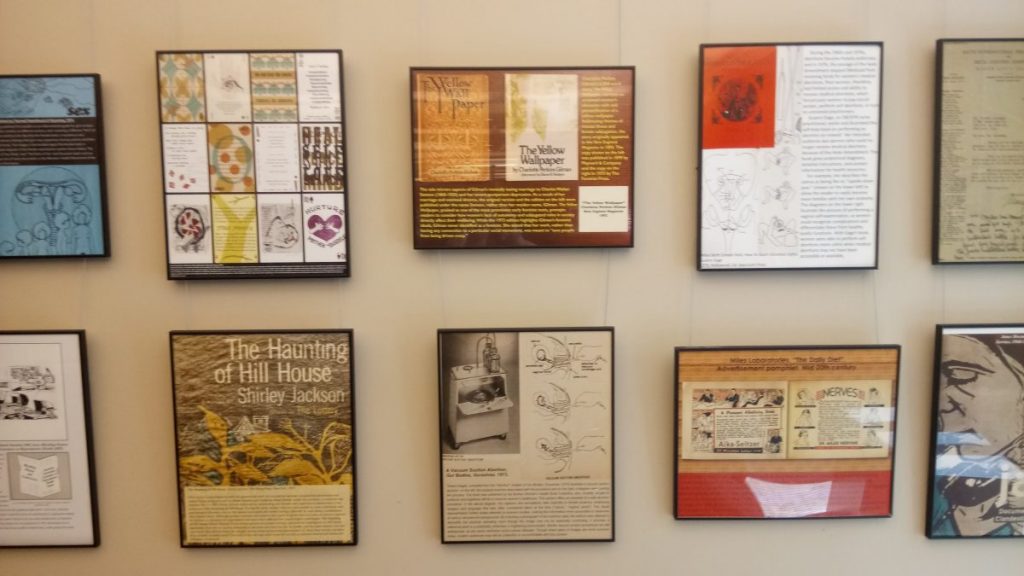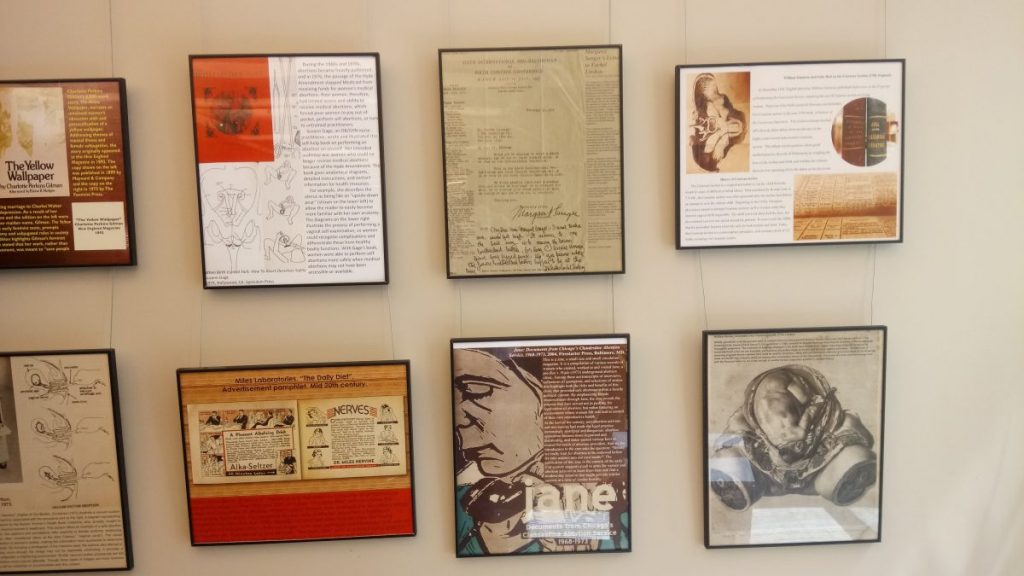Guest post by Seth S. LeJacq, Lecturing Fellow of Duke’s Thompson Writing Program. In Spring 2018, LeJacq received funding from Duke Learning Innovation for a student-curated exhibit in Perkins Library, produced in cooperation with the David M. Rubenstein Rare Book and Manuscript Library.
I designed a new Writing 101 course for the Spring 2018 semester, structuring it around a series of assignments building up to a student-curated exhibition of items from the David M. Rubenstein Rare Book and Manuscript Library. A requirement for first-years, Writing 101 classes introduce students to college-level academic writing. The faculty in the Thompson Writing Program teach these courses. We are subject specialists in a wide range of different academic fields, and teach classes on a great variety of different topics each year.

I am a historian specializing in the history of medicine. When I first arrived at Duke last summer, I was struck by the resources available in the area for those interested in the history of medicine, and decided to supplement current offerings at the university with a Writing 101 course dealing specifically with women and the history of medicine. This is a historically-significant topic, and as I’ve taught the history of medicine over the last decade I have found that it is also of great interest to students, who want to explore everything from historical health disparities to the roles of gender in the contemporary medical professions. Their interest is not only academic. Many undergraduates who study the history of medicine hope to pursue careers connected to health and healing and want to investigate the histories of those vocations. And, like all of us, our students inhabit and have to confront the world that this medical history has left us. Seemingly distant events can be startlingly relevant as we confront contemporary issues like deeply unequal healthcare access and quality and fierce battles over reproductive rights.
From the very start of my course planning, I knew that I wanted to have my students work with materials in the university’s special collections. Duke Libraries are renowned for their wide history of medicine holdings. I was particularly excited for them to spend time with the Lisa Unger Baskin collection, an important recent acquisition containing thousands of historical sources related to women and work, many of which are connected to medicine, health, and healing.

Working directly with these kinds of sources is central to historical research. What historians call “primary sources”–sources from whatever period you are studying–are the foundation of any historical account or analysis. One of the most valuable goals a history course can achieve is teaching students to critically evaluate and use sources, giving them analytical skills that they can apply in other areas of their lives as well. The questions that historians would ask of, say, an eighteenth-century doctor’s handwritten case notes (Who wrote this? For what purpose? For whom? How was it used? What can and can’t it tell us?) are also valuable when applied to the sources we encounter in our own daily lives–for example, the articles that pop up in our social media feeds.
I’ve found that students enjoy primary source work the most when they can take ownership over sources and are able to really get their hands dirty with the genuine articles. It’s a lot more fun and rewarding to go to the library and take a look at a three hundred-year-old book that you selected because it piques your interest than it is to print off and read a PDF of a digitized version of a reading assigned by your professor. And, of course, most sources (including most of the most interesting ones) aren’t available digitally at all. So I developed a sequence of assignments in which students would select a primary source available at Duke and then research and write about it in what’s called a “close read.” Finally, working in groups and building upon that research, they designed an exhibit display of their sources to be shown at the end of the semester in a group exhibition.
This last assignment is unusual for a history class. A long research paper is the standard end-of-term requirement for research-oriented courses. But I wanted our final project to achieve something a little different. I hoped to give students in the class an opportunity to think carefully about the audiences for historical research, and to produce something that would convey their hard-won findings to a broad group of people. Vanishingly few of us ever read history research papers. But everyone consumes public and popular representations of history—in, for example, books, newspaper and magazine articles, monuments and memorials, museums, movies and videogames, and much more. We often give little critical thought to such representations, but recent events have prompted an unusual amount of public discourse on the topic. The first-years in the three sections of this class arrived at Duke just as national attention turned to local landmarks commemorating the Confederacy, including the Durham Confederate Soldiers Monument, UNC’s “Silent Sam” statue, and Duke Chapel’s Robert E. Lee statue. I wanted this assignment to give students an opportunity to engage deeply with questions about how we convey history to others and consume history that’s presented to us.
Students worked in pairs to create one exhibition item, with my three sections (thirty-six students in total) producing a single group exhibit comprising eighteen items. We installed the exhibit, “Women and Medicine in Western History: Sources from the Rubenstein Library,” in the Student Exhibits space in Perkins Library in the beginning of May. This space can only support hanging flat images. This was ideal for us, though; given our training and resources, it would have been impossible to prepare and display the primary sources themselves. Instead, students photographed their items and designed display images and accompanying wall text. Learning Innovation’s generous financial support allowed me to print high-quality, large-format color images that we then framed. Groups were free to work with any source that interested them and related to course themes. Their selections tended to cluster around a few themes, including reproductive health, sexual education, and influential female medical figures.
A number of groups selected sources and images that dealt with sensitive material and topics, including visual depictions of abortion procedures and an illustrated pamphlet that treats female ejaculation in a frank fashion. While I had anticipated students addressing sensitive subjects and materials, these selections and the public and mixed-use nature of the display space raised unexpected concerns about some of the exhibit items. I worked with Meg Brown, The E. Rhodes and Leona B. Carpenter Foundation Exhibits Coordinator at Duke, and Dr. Naomi Nelson, Director of the Rubenstein Library, to address potential concerns and ensure that the final exhibition would be true to my students’ vision and goals while also being sensitive to the library’s concerns and to the many different populations that pass through the Perkins space. In the end, the library’s Executive Group gave us permission to hang all items as proposed without any obstruction, only asking that we have a “viewer discretion” notice–something that the students had already agreed they would like to include.
This meant that most groups were able to hang the exact design they wanted—though a few had preemptively changed their initial designs out of concern that the library would reject them. Nonetheless, this was a thrilling outcome and a clear articulation of the library’s commitment to supporting students’ free academic inquiry and presentation of their work. The decision also allowed students to introduce little-known gems from their school’s special collections to their community, and this entire process prompted rich classroom discussions of topics like cultural discomfort with depictions of women’s bodies and sexualities, gender and sexual cultures at the university, obscenity and censorship, and much more.

Shaping the course around this project radically transformed it from a traditional history or academic writing class. Active learning and public scholarship became the core of the semester, and putting together the exhibit required students to work with an entire community of people from outside our normal classrooms. We explored Rubenstein collection highlights and learned about primary source research at Duke in sessions designed and led by Kelly Wooten, Research Services and Collection Development Librarian for the Sallie Bingham Center and Librarian for Sexuality Studies; Laura Micham, Merle Hoffman Director of the Sallie Bingham Center; Rachel Ingold, Curator of the History of Medicine Collections at the Rubenstein; graduate intern Heather McGowan; and graduate field experience student Mary Kallem. Meg Brown aided us with every aspect of the exhibit, including helping–along with her assistant Yoon Kim–with the nitty-gritty of installation. Danette Pachtner, Librarian for Film, Video, and Digital Media and Women’s Studies at Duke, taught us how to use the university’s libraries for historical research beyond primary sources.
And a series of guest instructors led sessions that helped us think about how to analyze sources and present our findings. Lacey Hudspeth, librarian at the North Carolina School of Science and Mathematics, led a session on the biographies of religious healers; Susan Stein, a New York-based writer and teaching artist, led us in an exploration of how other fields translate historical texts for audiences; and UNC art historian Dr. Kathryn Desplanque taught us about curation and exhibition design, drawing on a similar project her students had undertaken at Duke and her own recent Humans of Paris exhibit at the Rubenstein.
In all of these ways, this non-traditional assignment reshaped and enriched the class, promoting active learning, involving us with the wider university community, and letting students experiment with genuine public scholarship.

